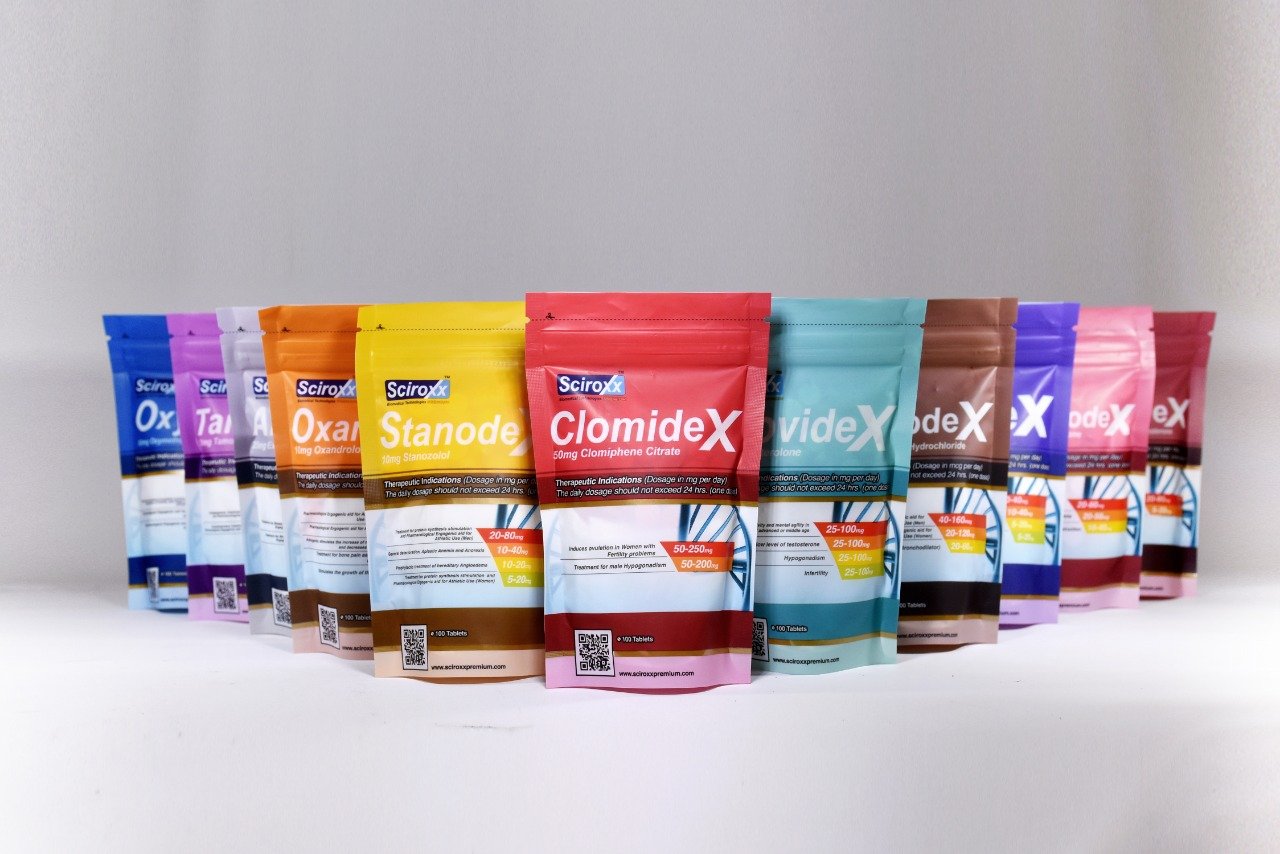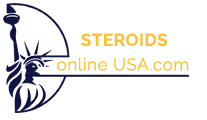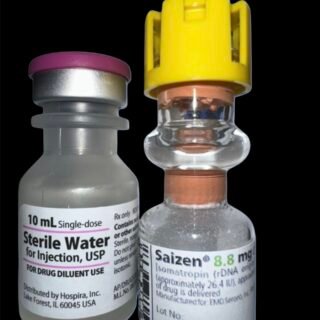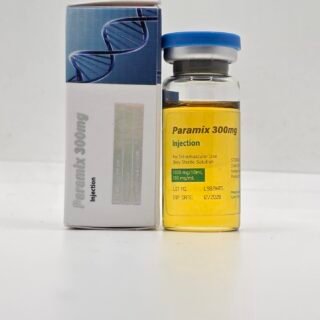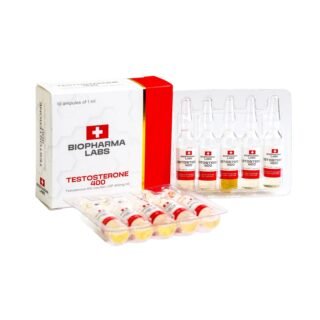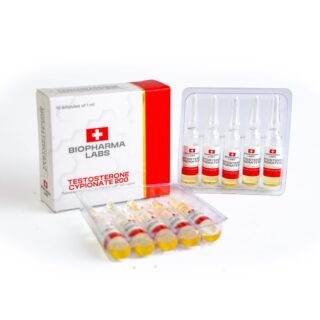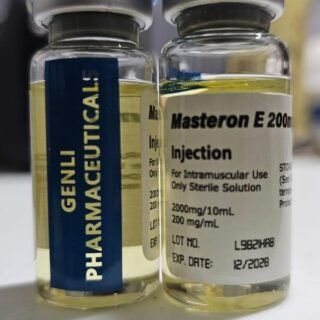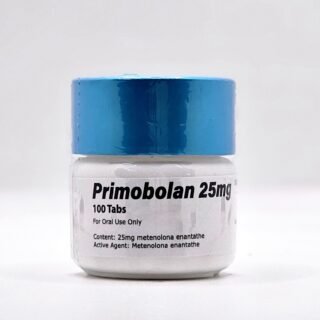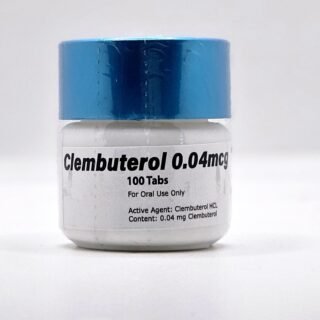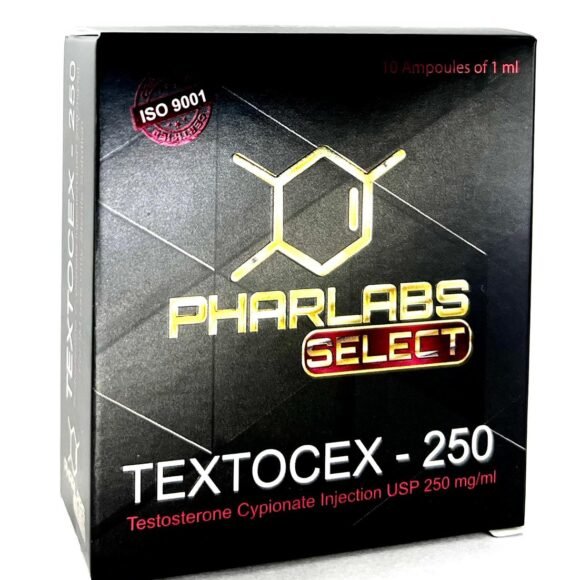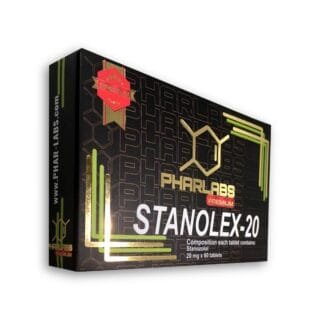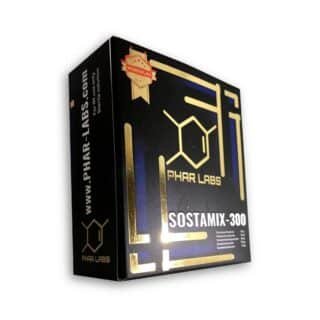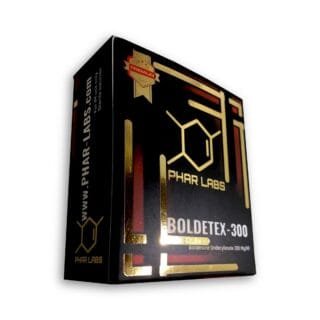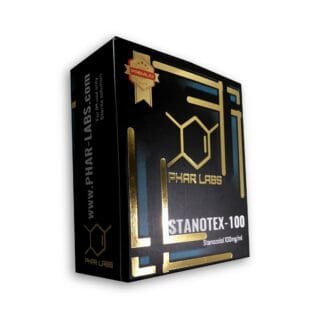Category
- Best Peptides for muscle growth
- Geno Pharma Domestic Warehouse 2 (Canada&USA)
- GP(Domestic Shipping US) Warehouse 1
- Human Pharma Premium
- Phar Labs Premium-Select
- Steroids on Sale USA, Real Steroids Online
- New arrivals in USA
- Most popular steroids in USA
- Antiestrogens / Gonadotropins
- Bangkok Steroid USA
- Biopharma Steroid USA
- British Dragon
- Anabolic Steroids for Horses
- Fat-burners
- Gen Pharma USA
- Medical Pharma Steroid USA
- Medical Tech Steroid USA
- Novocrine Steroids
- HGH USA
- Omega Labs Steroid USA
- Rotterdam Steroids USA
- SARMs USA
- Sciroxx
- Sydgroup Steroid USA
- Big vetenary Steroid USA
- Watson Steroids
- XT Labs Steroids
Most Popular steroids USA
-
 Saizen 8.8 mg (Somatropin) 26.4 UI Domestic USA
Saizen 8.8 mg (Somatropin) 26.4 UI Domestic USA
$115.00Original price was: $115.00.$98.00Current price is: $98.00. -
 PARAMIX 300 Genli Pharma – Trenbolone A, E & Hexa Mix 10 ml
PARAMIX 300 Genli Pharma – Trenbolone A, E & Hexa Mix 10 ml
$110.00Original price was: $110.00.$99.00Current price is: $99.00. -
 Testosterone 400 Biopharma 10 Ampoules
Testosterone 400 Biopharma 10 Ampoules
$99.00Original price was: $99.00.$75.00Current price is: $75.00. -
 Testosterone Cypionate 200 Biopharma 10 amp
Testosterone Cypionate 200 Biopharma 10 amp
$99.00Original price was: $99.00.$72.00Current price is: $72.00. -
 Drostanolone Enanthate 200mg 10 ml - Masteron Enanthate
Drostanolone Enanthate 200mg 10 ml - Masteron Enanthate
$110.00Original price was: $110.00.$90.00Current price is: $90.00. -
 Primobolan Pills 25mg 100 pills Domestic USA
Primobolan Pills 25mg 100 pills Domestic USA
$99.00Original price was: $99.00.$85.00Current price is: $85.00. -
 Clenbuterol for Sale 40mcg 100 Tabs - GP Premium Domestic USA
Clenbuterol for Sale 40mcg 100 Tabs - GP Premium Domestic USA
$99.00Original price was: $99.00.$65.00Current price is: $65.00.

Testosterone Cypionate Injection 250mg/ml Uses, Dosage & More
$120.00 Original price was: $120.00.$99.00Current price is: $99.00.
Out of stock
Share this page:
- Click to share on X (Opens in new window) X
- Click to share on Facebook (Opens in new window) Facebook
- Click to email a link to a friend (Opens in new window) Email
- Click to share on LinkedIn (Opens in new window) LinkedIn
- Click to share on Reddit (Opens in new window) Reddit
- Click to share on Pinterest (Opens in new window) Pinterest
- Click to share on Telegram (Opens in new window) Telegram
- Click to share on WhatsApp (Opens in new window) WhatsApp
- Click to share on Tumblr (Opens in new window) Tumblr
What is Testosterone Cypionate Injection?
Testosterone Cypionate Injection is formulated as an injectable solution designed to address specific hormone-related concerns. It typically comes in vials of varying concentrations, ensuring flexibility in dosing based on individual clinical needs. The solution is intended for deep intramuscular administration, often in the gluteal region, to facilitate gradual absorption into the bloodstream.
Basic Information About the Active Substance
The active component, testosterone cypionate, is an esterified form of testosterone. By modifying the hormone structure, it becomes more oil-soluble, which helps create a sustained release once injected. This prolongs its action in the body compared to free testosterone. Because it is an anabolic androgenic substance, testosterone cypionate supports the development and maintenance of male secondary sexual characteristics and has significant influence on muscle mass, bone density, and red blood cell production.
How Does Testosterone Cypionate Injection Work in the body?
Testosterone Cypionate functions by mimicking the activity of natural testosterone in tissues throughout the body. Once administered, the ester is gradually broken down to release active testosterone, which then binds to androgen receptors in various tissues. This binding initiates a cascade of cellular events that contribute to male sexual development, muscle growth, hair pattern changes, and other androgenic effects.
In addition to its role in sexual maturation, testosterone also influences nitrogen retention and protein synthesis. By promoting a favorable balance of nitrogen in the body, it can aid in muscle repair and growth, provided there is adequate dietary intake of protein and calories.
How is Testosterone Cypionate Absorbed and Processed?
When injected into muscle tissue, testosterone cypionate dissolves slowly, offering a more extended half-life than many other testosterone esters. After entering the bloodstream:
- Absorption: Occurs gradually over several days or weeks, depending on the specific dosage and individual metabolism.
- Metabolism: Primarily takes place in the liver, where testosterone is converted into various metabolites, including dihydrotestosterone (DHT) and estradiol (in smaller quantities).
- Excretion: Most of the metabolites are excreted via the urine as conjugates (glucuronides and sulfates). A smaller fraction is expelled in the feces.
This extended release profile allows less frequent injections while maintaining more stable blood hormone levels, which can be beneficial in managing hypogonadism and other hormonal deficiencies.
What is Testosterone Cypionate Injection Used For?
Testosterone Cypionate Injection is primarily indicated for males who have low or absent endogenous testosterone production. Common clinical scenarios include:
- Primary Hypogonadism: Conditions such as testicular failure due to developmental issues, injury, or surgical removal of the testes.
- Hypogonadotropic Hypogonadism: Cases where the pituitary or hypothalamus fails to signal the testes to produce sufficient testosterone (e.g., due to tumors, radiation, or trauma).
Purpose and Expected Benefits
By restoring testosterone levels to a normal range, this therapy aims to:
- Improve sexual function and libido.
- Support the development and maintenance of muscle mass.
- Enhance bone density and reduce the risk of osteoporosis.
- Promote normal fat distribution and red blood cell production.
- Improve overall mood and energy levels in individuals with clinically diagnosed low testosterone.
When used under proper medical supervision, Testosterone Cypionate Injection can significantly enhance quality of life for those with androgen deficiency, while minimizing risks associated with unregulated or excessive use.
Who Should Not Use Testosterone Cypionate Injection?
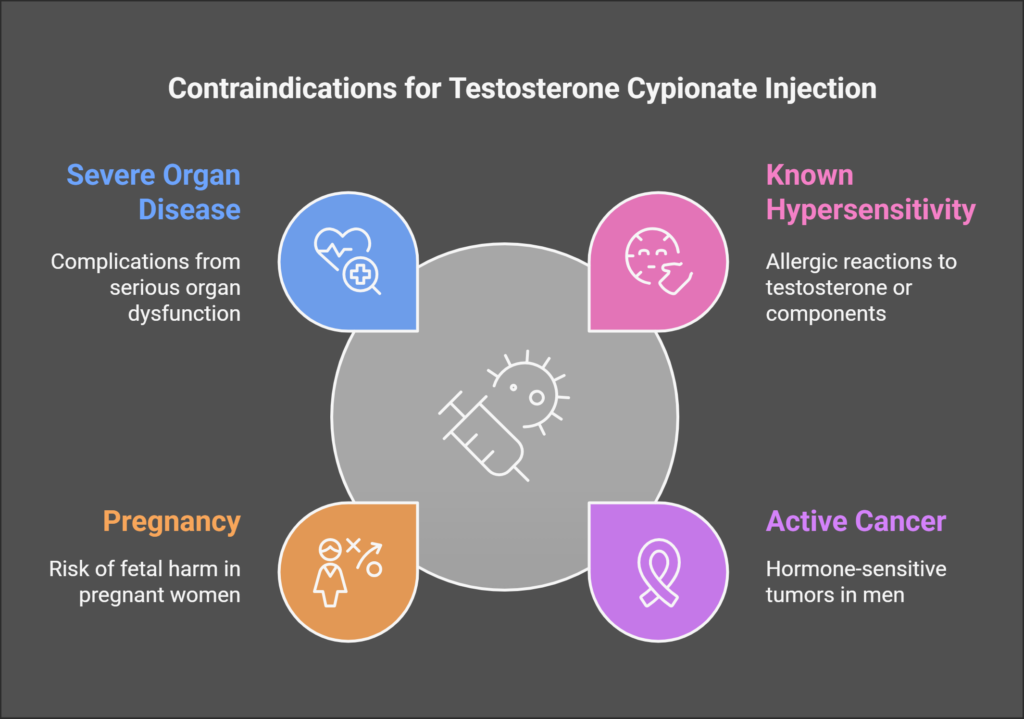
Testosterone Cypionate Injection should not be administered to individuals with certain underlying health issues that could be exacerbated by androgen therapy. These include:
- Known Hypersensitivity: Patients who exhibit allergic reactions to testosterone or any of the solution’s components.
- Active Breast or Prostate Cancer in Men: Testosterone may accelerate the progression of hormone-sensitive tumors.
- Pregnancy: Its use is contraindicated in women who are or may become pregnant due to the risk of fetal harm.
- Severe Cardiac, Renal, or Hepatic Disease: Patients with serious organ dysfunction may experience complications when given anabolic agents.
Risks Associated With Its Administration in Certain Patients
Even when not strictly contraindicated, caution is paramount for individuals who have pre-existing conditions such as benign prostatic hyperplasia (BPH), hypertension, or a history of thromboembolic events. Testosterone therapy can potentially worsen these conditions, so thorough evaluation and constant monitoring are crucial.
Important Warnings and Precautions for Testosterone Cypionate Injection
Before initiating treatment, a full medical assessment is essential to confirm a clinical need for testosterone replacement. This includes hormone level testing, evaluating any potential risk factors, and discussing lifestyle factors like diet and exercise. Throughout therapy, periodic follow-ups help track the patient’s response and detect signs of complications.
Serious Complications to Be on the Lookout For
- Venous Thromboembolism (VTE): Symptoms of blood clots, such as limb swelling or sudden shortness of breath, require immediate medical attention.
- Cardiovascular Concerns: Some studies suggest a possible link between testosterone treatment and an increased risk of cardiovascular events, although the data remains inconclusive.
- Potential for Abuse: Higher-than-prescribed doses or unauthorized use can lead to severe cardiovascular and psychiatric reactions.
How to Use Testosterone Cypionate Injection Safely
Common adverse effects may include changes in mood, increased acne, or fluid retention. Patients should be guided on recognizing early warning signs, such as persistent swelling or excessive irritation at the injection site, and report them promptly to their healthcare provider.
Monitoring Lab Tests and Clinical Signs
Regular laboratory evaluations, including liver function tests, hemoglobin, hematocrit, and lipid profiles, are recommended. These checks help detect conditions like polycythemia, altered cholesterol levels, or hepatic stress at an early stage. Clinical assessment of prostate health is also critical, especially in older males.
Interaction With Other Medications
Testosterone Cypionate may alter the effects of certain medications, including oral anticoagulants, insulin, or other hormonal treatments. Dose adjustments or close monitoring might be required to ensure therapeutic efficacy and reduce the risk of adverse reactions.
Managing Hormonal Fluctuations for Safe Use
Testosterone Cypionate injections can lead to significant fluctuations in hormone levels(1)(5), with a sharp increase in testosterone shortly after administration and a gradual decline over two weeks. This pattern means that patients may experience high androgen levels for a few days, followed by a drop before the next dose. These variations can contribute to mood swings, energy fluctuations, and potential side effects like increased estradiol levels or suppressed natural testosterone production.
To minimize these effects, consistent dosing schedules and proper monitoring are essential. Instead of relying solely on biweekly injections, some patients may benefit from adjusted dosing strategies to maintain more stable testosterone levels. Regular blood tests can help assess whether changes in frequency or dosage are necessary to avoid excessive peaks and crashes, ensuring a more balanced and effective therapy.
Effectiveness and Limitations of Biweekly Testosterone Cypionate Injections
Studies on chronic testosterone cypionate (TC) therapy indicate that while 200 mg injections every 14 days can improve libido and sexual function, they may not sustain optimal testosterone levels for the full two-week period. Despite notable benefits—such as increased potency in some patients—the study found that testosterone, estradiol, free testosterone, and bioavailable testosterone levels remained comparable to placebo before each injection, suggesting that hormone levels decline before the next scheduled dose. Additionally, luteinizing hormone (LH) was significantly suppressed, confirming the inhibition of natural testosterone production. These findings suggest that alternative dosing strategies, such as smaller but more frequent injections, could be explored to provide more stable hormonal balance and maximize therapeutic benefits(2).
Common and Serious Side Effects of Testosterone Cypionate Injection
While Testosterone Cypionate Injection is generally well-tolerated when used under proper medical supervision, certain unwanted effects can arise. Frequently reported issues include:
- Skin Concerns: Acne, oily skin, and hair pattern changes.
- Fluid Retention: Slight swelling in the ankles or feet due to sodium and water retention.
- Mood Changes: Fluctuations in libido, irritability, or emotional shifts.
Less common side effects may involve changes in liver enzymes, slight increases in red blood cell count (polycythemia), or temporary headaches. These reactions tend to vary between individuals and often resolve if the dosage is adjusted.
Symptoms That Require Immediate Medical Attention
Some side effects warrant urgent medical evaluation:
- Prolonged or Painful Erections (Priapism): Seek help if erections last excessively or become painful.
- Signs of Blood Clot Formation: Swelling, warmth, or redness in the limbs, and sudden shortness of breath could indicate venous thromboembolism.
- Severe Allergic Reaction: Hives, difficulty breathing, or significant swelling of the face and throat.
- Cardiovascular Symptoms: Chest pain, shortness of breath, or dizziness may suggest a serious event.
Risks of Misusing Testosterone Cypionate Injection
Testosterone Cypionate, along with other anabolic substances, carries a risk of misuse, particularly at higher-than-prescribed doses. This behavior can lead to:
- Cardiovascular Complications: Increased strain on the heart and potential blood pressure spikes.
- Hepatotoxicity: Greater liver stress or damage due to high-dose use.
- Psychiatric Effects: Mood swings, aggression, or even psychotic symptoms in severe cases.
Health Risks of High-Dose Testosterone Cypionate Injection
Excessive use of Testosterone Cypionate Injection can lead to hormonal imbalances and oxidative stress, affecting salivary gland function, liver health, and overall metabolic balance. A study on supraphysiological doses found alterations in saliva composition, increased oxidative damage, and elevated liver enzymes (AST, ALT), suggesting potential oral and systemic health risks.(4)
Signs of Dependence and Preventive Recommendations
Continual overuse of testosterone products may result in both physical and psychological dependence. Possible warning signs include:
- Persistently Seeking Higher Doses despite negative side effects.
- Withdrawal-Like Symptoms such as mood disturbances, low energy, and irritability upon cessation.
To lower the likelihood of dependence, follow medical advice strictly and avoid abrupt self-initiated dosage changes. Regular check-ups help ensure therapy remains within a safe therapeutic range.
What to Do in Case of Testosterone Cypionate Injection Overdose
Acute overdose of Testosterone Cypionate is rare, but if a significantly larger dose is administered accidentally, patients might experience intensified side effects such as severe fluid retention or profound mood changes. Immediate steps include:
- Contacting a Healthcare Professional: Promptly inform a doctor or pharmacist about the incident.
- Monitoring for Symptoms: Pay attention to any concerning developments, including chest pain or severe swelling.
Warning Symptoms and Emergency Protocols
Signs of overdose or serious complications might manifest as:
- Persistent Nausea or Vomiting
- Pronounced Edema or Rapid Weight Gain
- Excessive Irritability or Aggression
Seek medical care if these symptoms arise. Healthcare providers may recommend supportive treatments and reduce future doses to prevent further complications.
How to Use Testosterone Cypionate Injection: Dosage and Administration
Testosterone Cypionate Injection is used for hormone replacement therapy (HRT), hypogonadism treatment, and bodybuilding cycles. The dosage and frequency depend on the treatment goal, individual hormone levels, and response to therapy.
Testosterone Cypionate Injection for TRT (Testosterone Replacement Therapy)
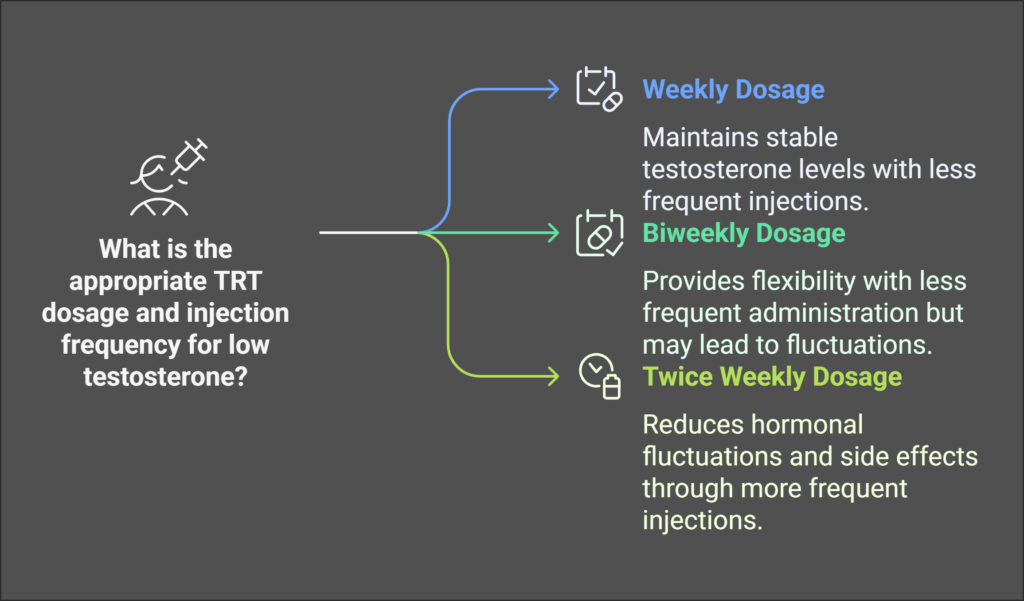
For men with clinically diagnosed low testosterone, TRT doses typically range between:
- 100–200 mg per week (or 200–400 mg every two weeks)
- Administered intramuscularly (IM), usually in the gluteal muscle
- Objective: Maintain testosterone within physiological levels (300–1000 ng/dL)
Some physicians prefer more frequent injections (e.g., 50–100 mg twice weekly) to reduce hormonal fluctuations and side effects like mood swings and estrogen conversion.
Testosterone Cypionate for Bulking Cycles in Bodybuilding
Testosterone Cypionate Injection is a foundation steroid in bulking cycles, known for promoting muscle growth, strength gains, and improved recovery. Due to its long ester, it provides sustained testosterone release, making it an ideal choice for mass-building phases.
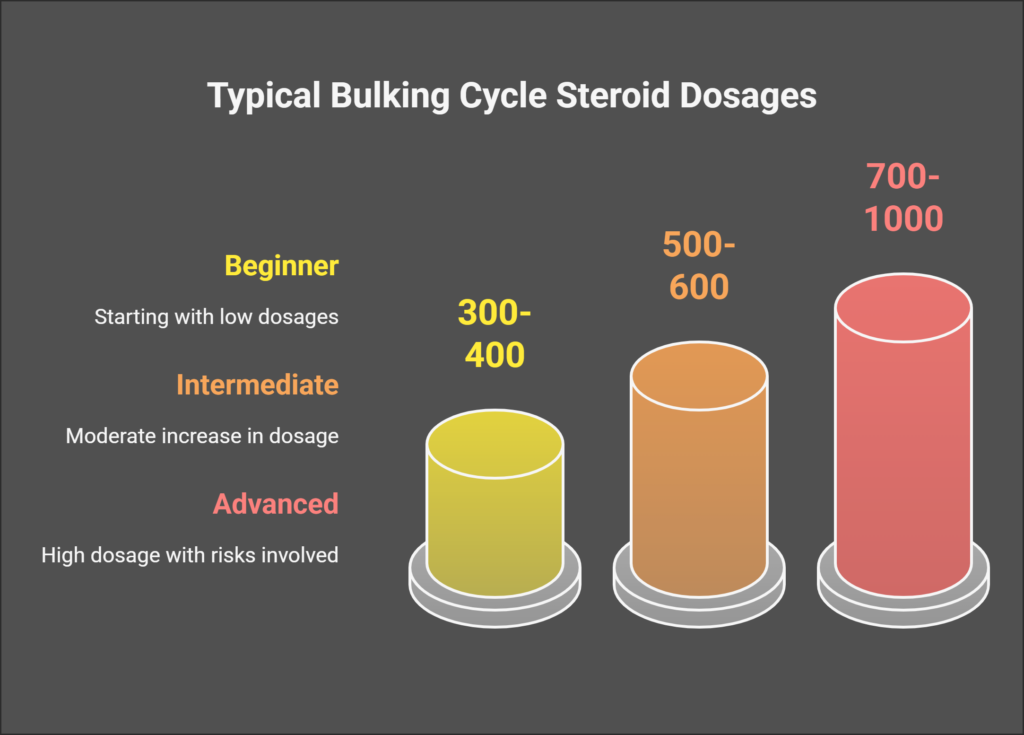
Typical Bulking Cycle Dosages:
- Beginner: 300–400 mg per week (split into two injections, e.g., Monday/Thursday)
- Intermediate: 500–600 mg per week
- Advanced: 700–1,000 mg per week (⚠️ Higher risk of side effects)
- Cycle Duration: 10–12 weeks
Why Bodybuilders Use Testosterone Cypionate for Bulking?
- Promotes protein synthesis and nitrogen retention, leading to faster muscle growth.
- Increases red blood cell production, improving endurance and performance.
- Enhances IGF-1 levels, boosting muscle recovery and hypertrophy.
- Maintains libido and overall well-being, preventing lethargy often caused by other steroids.
Common Testosterone Cypionate Bulking Stacks:
- With Deca-Durabolin (Nandrolone): Increases joint lubrication and muscle mass, reducing strain on tendons.
- Test Cypionate: 400–600 mg per week
- Deca-Durabolin: 300–400 mg per week
- Cycle Length: 12 weeks
- Aromatase Inhibitor (AI): Anastrozole (Arimidex) 0.5 mg EOD (to manage estrogen conversion).
- With Dianabol (Methandrostenolone): Kickstarts gains early in the cycle, maximizing strength and size.
- Test Cypionate: 500 mg per week
- Dianabol: 30–50 mg per day (first 4–6 weeks)
- Cycle Length: 10–12 weeks
- Liver Support: TUDCA/NAC due to Dianabol’s hepatotoxicity.
- Advanced Stack (Testosterone Cypionate + Trenbolone + Anadrol): For experienced users seeking extreme mass gain.
- Test Cypionate: 600–800 mg per week
- Trenbolone Enanthate: 300–400 mg per week
- Anadrol: 50 mg per day (first 4–6 weeks)
- AI + Prolactin Control: Arimidex + Cabergoline (if prolactin increases due to Trenbolone)
Testosterone Cypionate Injection: Alternative Formulations and Administration Methods
Testosterone Cypionate Injection is a widely used androgen therapy for hypogonadism, low testosterone levels, and gender-affirming treatments. While it is commercially available in 100 mg/mL and 200 mg/mL concentrations, some patients require alternative formulations due to allergies or sensitivities to excipients like cottonseed oil(3).
Compounded Testosterone Cypionate Injection and Bulk Drug Use
Recent discussions have considered adding Testosterone Cypionate Injection to the 503B Bulk Drug Substance List, allowing for compounded formulations with alternative carrier oils, such as grape seed or sesame oil, to improve tolerability and reduce adverse reactions. These formulations may also provide higher concentrations, offering more flexibility in dosing based on patient needs.
Intramuscular vs. Subcutaneous Administration of Testosterone Cypionate Injection
Traditionally, Testosterone Cypionate Injection is administered intramuscularly, but studies suggest that subcutaneous injection is a viable alternative. Subcutaneous administration offers easier self-injection, reduced pain, and improved adherence for long-term therapy. While further research is needed on specific compounded formulations, current evidence supports Testosterone Cypionate Injection as a safe and effective treatment when properly monitored.
By optimizing the formulation and injection method, healthcare providers can tailor Testosterone Cypionate Injection therapy to individual needs, enhancing both comfort and treatment effectiveness.
References:
(1) Nankin, Howard R. “Hormone kinetics after intramuscular testosterone cypionate.” Fertility and sterility 47.6 (1987): 1004-1009. https://www.sciencedirect.com/science/article/pii/S0015028216592371
(2) Nankin, H. R., Lin, T., & Osterman, J. (1986). Chronic testosterone cypionate therapy in men with secondary impotence. Fertility and sterility, 46(2), 300-307. https://www.sciencedirect.com/science/article/pii/S0015028216495294
(3) Gianturco, S. L., Pavlech, L. L., Storm, K. D., Yoon, S., Yuen, M. V., & Mattingly, A. N. (2019). Testosterone Cypionate: Summary Report. https://archive.hshsl.umaryland.edu/bitstream/handle/10713/12360/Testosterone%20cypionate_Final_2019_12.pdf?sequence=6&isAllowed=y
(4) Sampaio, Larissa Victorino, et al. “Effects of a supraphysiological dose of testosterone cypionate on salivary gland function in adult male Wistar rats.” The Journal of Steroid Biochemistry and Molecular Biology 243 (2024): 106587. https://www.sciencedirect.com/science/article/abs/pii/S0960076024001353
(5) Sun, Andrew Y. “Contemporary Management of Male Hypogonadism.” Rev Urol 23.1 (2024): e45-e52. https://articles-cdn.specialtynetworks.com/articles/23_1/Contemporary%20Management%20of%20Male%20Hypogonadism.pdf
Author
Dr. Daniel Martínez, MD – Expert in Endocrinology & Performance Optimization
With over 20 years of experience, Dr. Daniel Martínez, MD, specializes in hormonal balance, metabolic health, and performance enhancement. As an endocrinologist and nutrition specialist, he combines clinical expertise with scientific research, co-authoring studies on hormone therapy in bodybuilding to bridge the gap between medical science and athletic performance.
Related products
STANOLEX 20 Phar Labs Premium USA
$65.00Read moreSTANOLEX 20 Phar Labs Premium USA
Description: STANOLEX 20 Phar Labs Premium USA is a high-quality supplement that supports muscle growth, stimulates appetite, and burns fat. Each pill contains 20 mg of Stanozolol. Phar Labs is renowned for their strict quality standards and safe production processes.
Key Benefits:
- Stimulates appetite for enhanced nutrition intake
- Promotes muscle growth and development
- Aids in burning excess fat
Product Details:
- Main Component: Stanozolol 20 mg per pill
- Packaging: 60 tablets per bottle
SostaMix 300 Phar Labs Premium USA
$69.00Read moreSostaMix 300 Phar Labs Premium USA
Description: SostaMix 300 Phar Labs Premium USA is a premium testosterone blend designed to enhance physical performance and overall well-being. It contains five testosterone esters: Testosterone Propionato 30mg, Isocaproate 60mg, Phenylpropionate 60mg, Caproate 100mg, and Decanoate 50mg. Phar Labs, a reputable Asian pharmaceutical company, offers this product in packages of 10 ampoules of 1 ml or a 10 ml vial, with a dosage of 300 mg/ml.
Key Benefits:
- Enhances Performance: Boosts strength and endurance.
- Supports Muscle Growth: Promotes muscle development and recovery.
- Improves Well-being: Enhances mood and libido.
- Strengthens Bones: Supports bone health and reduces osteoporosis risk.
- Hormone Therapy: Maintains normal testosterone levels.
Product Details:
- Composition:
- Testosterone Propionato: 30mg/ml
- Testosterone Isocaproate: 60mg/ml
- Testosterone Phenylpropionate: 60mg/ml
- Testosterone Caproate: 100mg/ml
- Testosterone Decanoate: 50mg/ml
- Packaging: 10 ampoules of 1 ml or a 10 ml vial
- Dosage: 300 mg/ml
BoldeTex 300 Phar Labs Premium USA
$69.00Read moreBoldeTex 300 Phar Labs Premium USA: The Ultimate Guide to Boldenone Undecylenate
Description: BoldeTex 300 Phar Labs Premium USA is a potent anabolic steroid containing Boldenone Undecylenate at a concentration of 300mg/ml. This steroid is available in 10 ml vials or 10 ampoules of 1 ml each, offering flexibility and convenience in administration. Known for its strong anabolic properties and moderate androgenic effects, BoldeTex 300 is commonly used to promote muscle growth and enhance endurance.
Product Overview: BoldeTex 300 from Phar Labs Premium USA is a powerful steroid known for its remarkable properties in bodybuilding and performance enhancement.
Composition and Presentation:
- Active Ingredient: Boldenone Undecylenate 300 mg/ml
- Packaging: Available in 10 ampoules of 1 ml each
StanoTex 100 Phar Labs Premium USA
$65.00Read moreStanoTex 100 Phar Labs Premium USA: Ultimate Guide to Benefits and Usage
Description: StanoTex 100 by Phar Labs Premium USA is a powerful anabolic steroid designed to enhance strength, endurance, and overall aesthetic performance. Each 1 ml ampoule contains 100 mg of Stanozolol, and the product is available in packages of 10 ampoules or a 10 ml vial.
Presentation: Available in 10 ampoules of 1 ml each
Key Benefits:
- Increased Strength: Boosts overall strength for more effective workouts.
- Enhanced Endurance: Improves stamina, supporting prolonged physical activity.
- Aesthetic Performance: Promotes muscle definition and reduces body fat for a leaner physique.
Usage:
- Dosage for Men: 25-50 mg per day.
- Dosage for Women: 5-10 mg per day.
- Administration: Intramuscular injection, rotating sites to prevent irritation.
- Cycle Duration: 6-8 weeks for optimal results.
Why Choose StanoTex 100: StanoTex 100 by Phar Labs Premium USA is a top choice for athletes and bodybuilders seeking high-quality, effective steroid options to enhance physical performance and appearance. Always consult a healthcare professional before starting any new supplement regimen.
Pay with WISE APP or Remitly
Pay with WISE App or Remitly
Fast money transfers from USA for fast delivery of steroids
Secure delivery in USA
100% reliable shipping in USA
24x7 Support
Online 24 hours
Low cost delivery
Great shipping prices in USA
BULK ORDER DISCOUNT
If you are a reseller in the USA you can get a special DISCOUNT, we can give you up to 50% or more on bulk orders. If you want to make a bulk order, we can negociate for orders of over USD$4,000, contact us by email.
Steroids info
